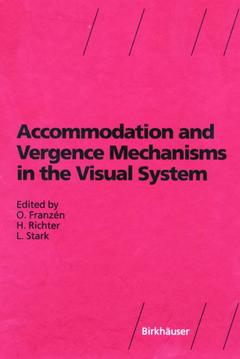Accommodation and Vergence Mechanisms in the Visual System, 2000
Langue : Anglais
Coordonnateurs : Franzen Ove, Richter Hansn, Stark Lawrence

This conference was instigated by a combination of factors: The nature of the problem, the wide spread occupational epidemiology reported on eye symptoms and eye fatigue in the workplace, and the organizers' awareness of the complexity of the scientific and clinical bases of knowledge that might be usefully applied. The introduction of new methods into system neurobiology provides new insights into how we receive and process information from the external world, and act upon it. New, non-invasive methods have opened the way to direct observation of the human brain in action. Due particularly to the interaction between the visual and oculomotor requirements involved, several clinical and scientific fields intersect when these issues are considered. To provide clear vision the accommodative and pupillary mechanisms are used. To maintain binocularity, the ver gence oculomotor system, sensitive to fatigue, must attain congruence with accommodative levels. This accommodation-vergence linkage was a focus of our symposium.
I CNS pathways, single unit, neural population and structural correlates of the accommodative system.- Neuronal circuits for accommodation and vergence in the primate.- Neural codes for three-dimensional space.- Neuronal connectivity between the accommodative and active fixation systems.- The pupillary light reflex, accommodation and convergence: Comparative considerations.- Vergence eye movement and lens accommodation: Cortical processing and neuronal pathway.- Research on dynamic accommodation using TDO III (Three Dimensional Optometer III) and MEG (Magnetoencephalography).- Neuroanatomical correlates of the near response: Voluntary modulation of accommodation in the human visual system.- Functional neuroanatomy of the human near/far response of the visual system to blur cues: Fixation to point targets at different viewing distances.- Spatial contrast sensitivity and visual accommodation studied with VEP (Visual Evoked Potential), PET (Positron Emission Tomography) and psychophysical techniques.- II Autonomic nervous system, microfluctuations and resting state of accommodation.- Accommodation and the through-focus changes of the retinal image.- Accommodative microfluctuations: A mechanism for steady-state control of accommodation.- Pharmacology of accommodative adaptation.- Behavioral links between the oculomotor and cardiovascular systems.- III Developmental/functional aspects of accommodation.- Development of accommodation and vergence in infancy.- The accommodative response to blur in myopic children.- The role of muscarinic antagonists in the control of eye growth and myopia.- Accommodation, age and presbyopia.- Chromatic stimulus for accommodation to stationary and moving targets.- Error signal detection and dynamics of accommodation.- Mode switching in control of accommodation.- A modified control model for steady-state accommodation.- Binocular accommodation.- IV Health and clinical aspects of accommodation/vergence.- Vertical vergence — normal function and plasticity.- Predicting accommodative performance in difficult conditions: a behavioral analysis of normal variations of accommodation.- The influence of oculomotor function on the optical correction for night myopia.- Effects of neck muscles proprioception on eye position and vergence movements.- Accommodation/vergence/fixation disparity and synergism of head, neck and shoulders.- Changes in accommodation and vergence following 2 hours movie viewing through bi-ocular head-mounted display.- Development of myopia due to environmental problems. A possible interaction of anti-cholinesterase compounds examined by accommodative adaptation.- Epilogue.- Nearwork and visual well-being: A possible contribution of neuroscience.
LATEST INTERDISCIPLINARY RESEARCH DESCRIBES THE INTERACTION BETWEEN THE VISUAL AND OCULOMOTOR SYSTEMS IN THE BRAIN IS BASED ON THE FIRST INT. SYMPOSIUM ON ACCOMODATION/VERGENCE MECHANISMS IN THE VISUAL SYSTEM, STOCKHOLM,
Date de parution : 10-2013
Ouvrage de 346 p.
17x24.4 cm
Date de parution : 01-2000
Ouvrage de 346 p.
15.5x23.5 cm
Thèmes d’Accommodation and Vergence Mechanisms in the Visual System :
Mots-clés :
Nervous System; anatomy; neuroscience; physiology; visual evoked potential (VEP)
© 2024 LAVOISIER S.A.S.



